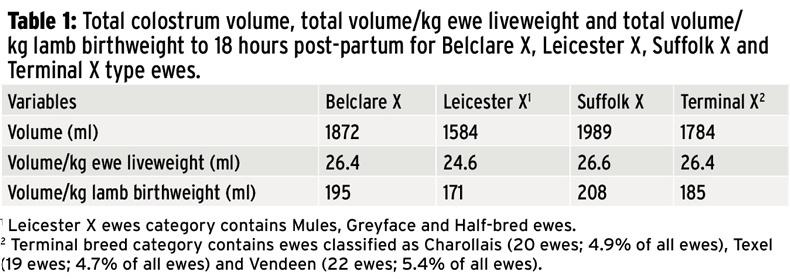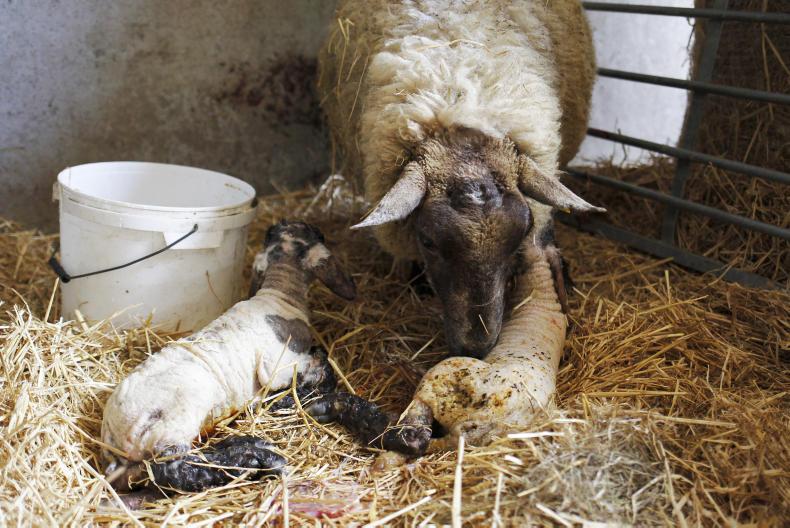The first 48 hours of a lamb’s life represent the highest risk of mortality. During this period, approximately half of all lamb mortality occurs. Two of the primary causes of mortality at this time are hypothermia and disease, which often occur as a result of inadequate colostrum.
In the first hours of life, the newborn lamb is dependent on consuming adequate quantities of good-quality colostrum to stave off hypothermia and disease. Colostrum has three main functions – it will provide the lamb with nutrients (especially energy for heat production), passive immunity and acts as a laxative to allow the lamb to begin passing faeces. Failure to provide the lamb with sufficient colostrum during the first hours after birth will reduce the rate of lamb survival among the flock as well as impacting upon future lamb performance.
When the lamb is born, there is a large and immediate demand for heat production to maintain body temperature. The lamb has some special energy reserves (namely brown adipose tissue or brown fat) which it quickly mobilises to produce heat. This brown fat is present in relatively small quantities and its presence and availability is influenced by the pregnancy nutrition of the ewe. If the ewe is underfed, this energy reserve is reduced. Also if mineral nutrition, especially selenium and iodine, is inappropriate, the lamb’s ability to use this energy is reduced.
Therefore colostrum production and intake is essential to support the heat production requirements of the lamb. Colostrum requirements for lambs born indoors, between 2°C and 10°C, over the first 24 hours of life are in the range of 143ml/kg to 175ml/kg birthweight. Environment, lamb weight and the energy concentration of the colostrum all influence the level of colostrum required by the lamb. Where lambs are born outdoors or in colder air temperatures, the energy requirement of the lamb increases, with colostrum requirement increasing as a result.
Generally speaking, the amount of colostrum required to meet lamb energy requirements will be higher than the amount required to meet the immunoglobulin requirement of the lamb.
At lambing time there are two major issues which we all want to avoid. Firstly, we have the issue of weak lambs lacking in vigour and secondly, ewes lambing down without milk/colostrum. Pre-lambing nutrition is a key driver of colostrum production. Energy intake right throughout the final two months of pregnancy and protein intake of the ewe during the last month of pregnancy are crucial.
Poor colostrum production is often associated with insufficient protein intake. In the last two to three weeks of pregnancy, the ewe will require around 200g of protein per day. The quality of the protein is also important, with soya-bean meal representing a very good source of protein for the ewe in late pregnancy.
There are a number of other factors that can affect the volume and quality of colostrum produced from the ewe, such as ewe breed, gestation length and ewe age. The typical colostrum production of different ewe breeds during the first 18 hours post-partum is shown in Table 1. Clear differences exist between breeds, but where pre-lambing nutrition is correct, all breeds should be able to meet the requirements of a lamb born indoors.

Within breed type, there will also be variation in the amount of colostrum produced, particularly during the first hour after lambing, so it is vitally important to ensure lambs are up suckling and not showing signs of hunger. Where ewe colostrum production drops below 60-80ml/kg birthweight during the first 18 hours of life for lambs born indoors, between 2°C and 10°C, then substitute colostrum should be provided. Substitute colostrum from artificial colostrum or cow’s colostrum will not be as beneficial to the lamb as ewe colostrum but where necessary will help prevent hypothermia and provide nutrients in the first hours of life.
Adequate and timely intake of colostrum also has important long-term effects on the lamb’s performance. If colostrum intake is inadequate, or lacking, then lamb growth rate to slaughter will be reduced, as indicated in some recent trial work at Lyons Farm, UCD. This has the net result that the lambs take longer to finish and require more feed to finish, reducing the efficiency of the system.
This is partly linked to the wide range of bioactive compounds present in colostrum, which in addition to providing energy and immunity, also have a priming effect on the digestive tract of the lamb, making them better able to utilise nutrients as they grow.
Know the requirements of your ewe. These are linked to ewe liveweight, litter size and body condition score.Know the quality of your available feeds. A common problem is the overestimation of the quality and consumption of forages.Ensure correct mineral nutrition, especially selenium, iodine, cobalt and copper to support lamb vigour. Read more
Special focus: lambing 2017
The first 48 hours of a lamb’s life represent the highest risk of mortality. During this period, approximately half of all lamb mortality occurs. Two of the primary causes of mortality at this time are hypothermia and disease, which often occur as a result of inadequate colostrum.
In the first hours of life, the newborn lamb is dependent on consuming adequate quantities of good-quality colostrum to stave off hypothermia and disease. Colostrum has three main functions – it will provide the lamb with nutrients (especially energy for heat production), passive immunity and acts as a laxative to allow the lamb to begin passing faeces. Failure to provide the lamb with sufficient colostrum during the first hours after birth will reduce the rate of lamb survival among the flock as well as impacting upon future lamb performance.
When the lamb is born, there is a large and immediate demand for heat production to maintain body temperature. The lamb has some special energy reserves (namely brown adipose tissue or brown fat) which it quickly mobilises to produce heat. This brown fat is present in relatively small quantities and its presence and availability is influenced by the pregnancy nutrition of the ewe. If the ewe is underfed, this energy reserve is reduced. Also if mineral nutrition, especially selenium and iodine, is inappropriate, the lamb’s ability to use this energy is reduced.
Therefore colostrum production and intake is essential to support the heat production requirements of the lamb. Colostrum requirements for lambs born indoors, between 2°C and 10°C, over the first 24 hours of life are in the range of 143ml/kg to 175ml/kg birthweight. Environment, lamb weight and the energy concentration of the colostrum all influence the level of colostrum required by the lamb. Where lambs are born outdoors or in colder air temperatures, the energy requirement of the lamb increases, with colostrum requirement increasing as a result.
Generally speaking, the amount of colostrum required to meet lamb energy requirements will be higher than the amount required to meet the immunoglobulin requirement of the lamb.
At lambing time there are two major issues which we all want to avoid. Firstly, we have the issue of weak lambs lacking in vigour and secondly, ewes lambing down without milk/colostrum. Pre-lambing nutrition is a key driver of colostrum production. Energy intake right throughout the final two months of pregnancy and protein intake of the ewe during the last month of pregnancy are crucial.
Poor colostrum production is often associated with insufficient protein intake. In the last two to three weeks of pregnancy, the ewe will require around 200g of protein per day. The quality of the protein is also important, with soya-bean meal representing a very good source of protein for the ewe in late pregnancy.
There are a number of other factors that can affect the volume and quality of colostrum produced from the ewe, such as ewe breed, gestation length and ewe age. The typical colostrum production of different ewe breeds during the first 18 hours post-partum is shown in Table 1. Clear differences exist between breeds, but where pre-lambing nutrition is correct, all breeds should be able to meet the requirements of a lamb born indoors.

Within breed type, there will also be variation in the amount of colostrum produced, particularly during the first hour after lambing, so it is vitally important to ensure lambs are up suckling and not showing signs of hunger. Where ewe colostrum production drops below 60-80ml/kg birthweight during the first 18 hours of life for lambs born indoors, between 2°C and 10°C, then substitute colostrum should be provided. Substitute colostrum from artificial colostrum or cow’s colostrum will not be as beneficial to the lamb as ewe colostrum but where necessary will help prevent hypothermia and provide nutrients in the first hours of life.
Adequate and timely intake of colostrum also has important long-term effects on the lamb’s performance. If colostrum intake is inadequate, or lacking, then lamb growth rate to slaughter will be reduced, as indicated in some recent trial work at Lyons Farm, UCD. This has the net result that the lambs take longer to finish and require more feed to finish, reducing the efficiency of the system.
This is partly linked to the wide range of bioactive compounds present in colostrum, which in addition to providing energy and immunity, also have a priming effect on the digestive tract of the lamb, making them better able to utilise nutrients as they grow.
Know the requirements of your ewe. These are linked to ewe liveweight, litter size and body condition score.Know the quality of your available feeds. A common problem is the overestimation of the quality and consumption of forages.Ensure correct mineral nutrition, especially selenium, iodine, cobalt and copper to support lamb vigour. Read more
Special focus: lambing 2017







 This is a subscriber-only article
This is a subscriber-only article











SHARING OPTIONS: